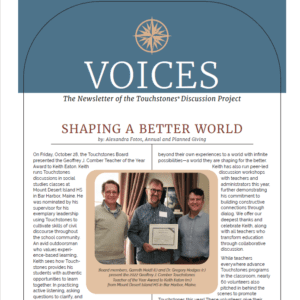By Howard Zeiderman
For several decades, many reputable business magazines and corporate leaders have sounded an alarm: future generations aren’t being prepared for a world that requires a new set of skills. Some of those “new” skills include the ability to collaborate and share leadership in a 21st Century globalized and technological world.

During a Touchstones workshop for deans and directors in a recent leadership development retreat, small groups explore how building a brand requires input from all members of a team.
These skills aren’t meant to replace skills designed for large-scale mass production and distribution. Those skills are still necessary. However, a highly interconnected and technologically evolving world introduces new opportunities and challenges. In this world, new knowledges constantly emerge, and related business decisions require input from many different types of experts, as activity in one region and one market bears on other regions and other markets. The skillset required to complement those we’ve been teaching and learning for more than 150 years are, not surprisingly, as complex as the world that requires them.
The World Economic Forum’s 2016 “The Future of Jobs” report indicates that skills of creativity, interpersonal dexterity, emotional intelligence, judgment and decision-making, service orientation, ability to find common ground, and cognitive flexibility are essential skills in our world that is increasingly transformed by technology. But how are those skills being developed—in our children, our young adults, and our existing workforce and leadership? Touchstones programs are indeed addressing some of this urgent need, but there is a lot of work yet to be done.
Recently, we were hired to develop and run a customized Touchstones program within a large corporation to help a senior management team focus on developing some of these key skills. The team’s leader recognized she wasn’t tapping into the full potential represented within her managers. There were members of her group who always spoke in meetings and others who were much quieter. Some rarely spoke at all, and yet each was a valued member of the team. What, she wondered, did they need to learn to do differently to make sure everyone’s voice and ideas were available and accessible to the entire team?
Over four, five-hour workshop sessions, each member of the team worked on active listening and what it means to create an environment in which each person’s viewpoint is welcomed and respected. By the time we finished our work with the group, many had practiced running Touchstones discussions— sharing responsibility for leading and bringing in all members of the team. Since then, that group has integrated their Touchstones practice into their monthly staff meetings, rotating leadership month to month to ensure their continued development.
Next month, we’ll run similar leadership development programs at the University of Nevada, Las Vegas within the Emergency and Crisis Management Master’s of Science Program. The participants are enrolled in a blended learning program, which brings them to campus several times a year to work together in person. Touchstones will be a central part of building connections and trust within the cohort, as part of strengthening participants’ abilities to collaborate across key leadership positions even in times of great uncertainty.
We’ll also be traveling to Montgomery, Alabama to provide professional development and leadership training for members of the Community College Association of Alabama consortium. As that organization looks to foster future leadership from within its younger managers, Touchstones will feature as a primary tool for augmenting existing skillsets.



 Join the
Join the